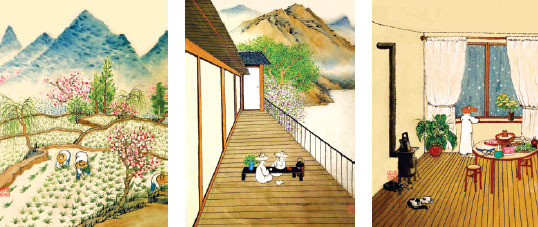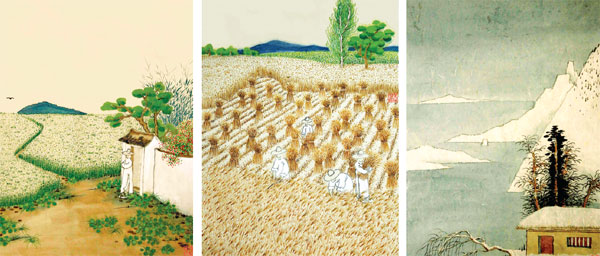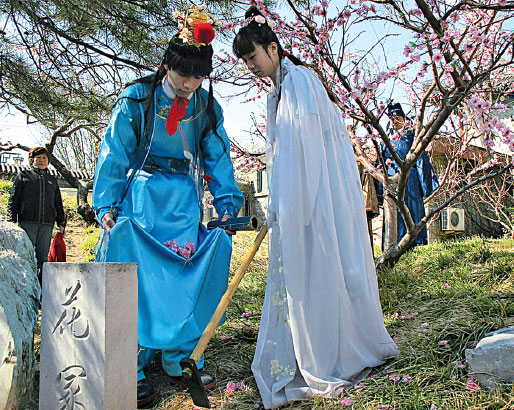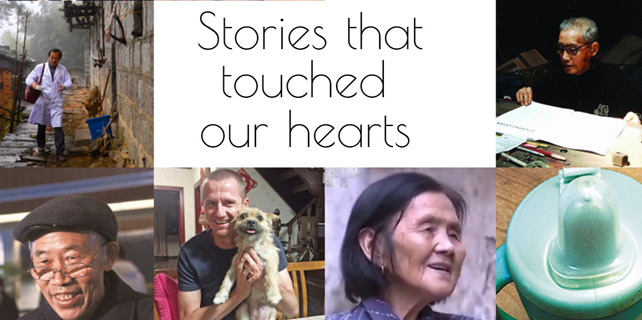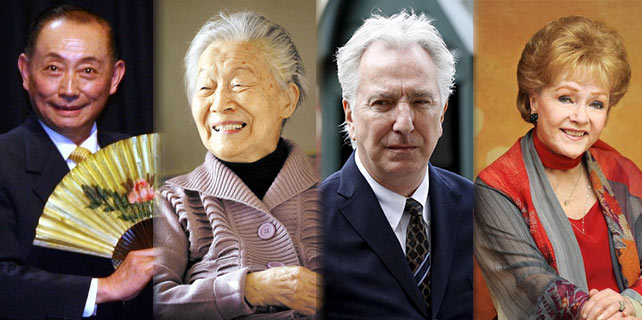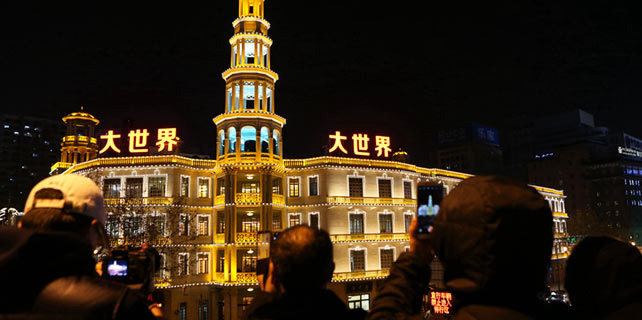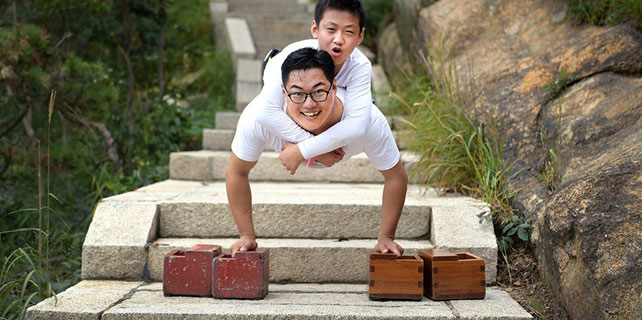Treasured seasons
China's 24 Solar Terms have inspired poets and artists, as well as aiding farmers - and now they are recognized as being of international importance. Lin Qi and Wang Kaihao report
As spring thunder wakes animals from their winter sleep, sprouting plants breathe an air of freshness into the world. The temperature rises and increasing rainfall turns the mountains green. When the heat of summer recedes, farmers prepare for harvest and, as snow falls, mountains are enveloped in pure white.
The transformation of the landscape brought about by the changing seasons has long been the subject of poems, paintings, nursery songs and other forms of art.
Beijing-based artist Dong Lin, 25, depicts these climate phenomena in a series of ceramic sculptures, 24 Solar Terms, which she began a year ago in Jingdezhen, China's ceramic capital in East China's Jiangxi province.
Based on observations of the sun's annual motion, the ancient Chinese created a lunar calendar dividing the year into 24 segments, each given a specific "solar term" (jieqi). The system provided a time frame for agriculture, everyday life and festivals.
Dong is now exhibiting the first six ceramics of her ongoing series in a solo exhibition at Beijing's Soka Art Center. She has named each after a solar term, such as Insects Awakening (jingzhe) and Grain Rain (guyu).
"The idea came to me when I saw a Weibo posting about the solar terms. The names sounded so poetic and inspired my imagination," she says.
Dong used the "zhan jing pan" technique, a method of creating miniature landscapes used during the Han Dynasty (206 BC-220). She molded mountains, rocks and animals, and arranged them in a ceramic pot to portray natural scenery corresponding to a solar term.
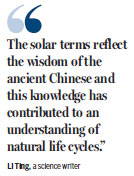
Each work was given a different colored glaze. The red tone of End of Heat (chushu) indicates summer fever; the yellow of Autumnal Equinox (qiufen) suggests a harvest; and the silver of Light Snow (xiaoxue) symbolizes the arrival of winter.
"Dong's works not only offer a novel visual experience," says exhibition curator Sun Yiwei. "They also have a lingering charm because of deeply-rooted Chinese cultural traditions."
The solar terms recently found favor with the Intergovernmental Committee for the Safeguarding of Intangible Cultural Heritage, part of the United Nations Educational, Scientific and Cultural Organization.
On Nov 30, the committee added the Chinese 24 Solar Terms to the Representative List of the Intangible Cultural Heritage of Humanity during its 11th session held in Addis Ababa, Ethiopia.
The committee examined 37 applications bidding to be inscribed on the list. The addition of the solar terms increased the number of Chinese items on the list to 31.
The committee said the inscription would give Chinese people an awareness of "the importance of transmitting and safeguarding intangible cultural heritage at the national level, as well as an enhanced understanding of regional variations of solar terms".
It also said the inscription would advance international "dialogue between traditional systems of knowledge about time", so that people would appreciate and respect cultural diversity and human creativity.
Fifth invention
The solar terms are viewed as "China's fifth invention" in international meteorological circles. The system originated in areas along the Yellow River which for a long period were China's political and economic center.
A solar term is any of 24 points on the traditional Chinese lunisolar calendar which matches an astronomical event or signifies a natural phenomenon. The points are spaced 15 degrees apart along the ecliptic and were used to keep lunisolar calendars synchronized with the seasons.
Surviving historical files show that Lyushi Chunqiu (Master Lyu's Spring and Autumn Annals), an encyclopedic Chinese classic text compiled around 239 BC, first recorded eight terms corresponding to four seasons.
Huai nanzi, a classical essay collection from 139 BC, mentioned 24 terms identical to those of today.
In 104 BC, the Taichu Calendar (the Grand Inception Calendar), China's first official calendar with complete written records, integrated 24 solar terms to reaffirm their status in astronomy, based on which successive dynasties created their own official calendars.
Having been merged into the Gregorian calendar, the system has been passed down for generations to guide agriculture.
Liu Xiaofeng, a history professor at Tsinghua University, says the solar terms predict a general trend of temperature and rainfall and, therefore, were essential for Chinese farmers, who need to make the best use of climatic conditions.
The different periods are marked nationwide with rituals and festivities, although there are variations between regions and ethnic groups.
During the Beginning of Spring (lichun) solar term, that normally falls on Feb 3, 4 and 5, people in Suichang county, eastern Zhejiang province, used to set off firecrackers, arrange plum blossoms in pots and hold sacrificial ceremonies to the gods of the land, among other spring celebrations. By doing so, they notified each other of the need to prepare for field plowing.
The ceremonies, known as "banchun quannong (encouraging agrarian activities at the arrival of spring)", came to halt in the chaotic early 20th century. They have been revived by some villages since the 1980s and a folk culture museum was opened in 2009 displaying objects and materials relating to local agricultural development. The traditions were inscribed on the list of State-level intangible cultural heritage in 2011, being preserved as an extended item of the 24 Solar Terms.
Liu says that although more than half of the Chinese population now live in cities, the system is still important today as it encourages a harmonious relationship with nature and sustainable development.
Li Ting, a Beijing-based popular science writer and postdoctoral researcher of atmospheric physics, says these days the solar terms have more cultural than astronomical significance.
"Weather forecasts based on scientific measurements have become so advanced that they can provide a better guide for agriculture," she says.
"However, the solar terms reflect the wisdom of the ancient Chinese and this knowledge has contributed to an understanding of natural life cycles."
Common festivals
She adds that some solar terms are now common festivals, such as the Qingming Festival that marks the term of Fresh Green, during which people nationwide make excursions to the countryside and worship their ancestors.
She also notes that because many solar term-associated events are held in countryside, they are under threat as more people move to urban areas.
Efforts are thus being made at both grassroots and national level to transmit some of the cultural cohesion provided by solar terms to the younger generation, through formal and informal education.
Wang Yingde, a researcher at the Beijing-based China Agricultural Museum, says the museum has worked with several "representative communities" to formulate a five-year plan, beginning in 2017, for a series of measures designed to protect the traditions.
Communities boasting varieties of solar term traditions include Anren county, in central Hunan province, where people trade herbal medicines at fairs and cook them with pork, an annual routine to mark the Spring Equinox (chunfen).
Wang says courses on how to safeguard traditions will be offered in certain communities and then spread to more areas.
He says schoolbooks about solar terms will be compiled and relevant oral and paper documents and artifacts will be collected and cataloged in digital files, as well as being shown in exhibitions.
He adds that the museum runs a website dedicated to the 24 Solar Terms which provides basic information, photos and videos. This will be enhanced by incorporating interactive digital technologies to engage more people, especially children and teenagers.
Bamo Qubumo, an expert on ethnic literature and the conservation of intangible cultural heritage at the Chinese Academy of Social Sciences, says the vitality of solar terms can only be maintained when they are part of everyday life for young people. Advanced digital technologies are of great help in achieving this.
She says more apps, images and such things as animations and online games are needed to engage young people's interest.
"The 24 Solar Terms boast an extensive sea of knowledge and practices that all Chinese people should explore," she says, "because every one of us is responsible for keeping the traditions alive."
Contact the writer through linqi@chinadaily.com.cn
|
From left: Three illustrations from Yu Shicun's The Book of Time - Grain Rain (guyu), Lesser Heat xiaoshu) and Light Snow (xiaoxue) by artist Lao Shu. Yu is the author of some of China's bestsellers,including Supernormal Words. Photos Provided To China Daily |
|
Another three illustrations from Yu's book-Lesser Fullness (xiaoman), Grain in Ear (mangzhong) and Heavy Snow (daxue) by artist Lao Shu. Provided To China Daily |
|
The Qingming Festival at Beijing's Grand View Garden attracts many classical culture lovers. Provided To China Daily |
(China Daily 01/02/2017 page1)







